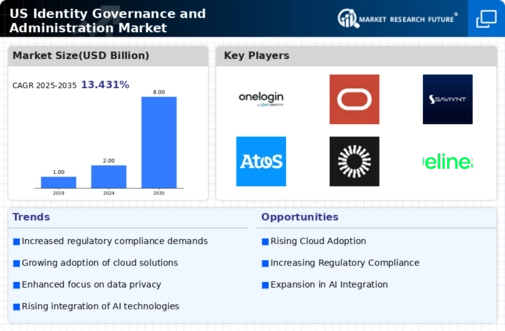Increased Cloud Adoption
The rapid shift towards cloud-based services is a significant driver for the identity governance-and-administration market. As organizations migrate their operations to the cloud, they face new challenges in managing user identities and access rights. The need for effective identity governance solutions becomes evident, as businesses must ensure that their cloud environments are secure and compliant. By 2025, it is anticipated that over 80% of enterprises will have adopted cloud services, creating a substantial demand for identity governance tools that can seamlessly integrate with these platforms. This trend indicates a growing recognition of the importance of identity management in maintaining security and compliance in cloud environments, thereby propelling the market forward.
Rising Cybersecurity Threats
The identity governance-and-administration market is experiencing heightened demand due to the increasing frequency and sophistication of cybersecurity threats. Organizations are compelled to implement robust identity governance frameworks to protect sensitive data and ensure compliance with regulations. In 2025, it is estimated that cybercrime will cost businesses globally over $10 trillion annually, underscoring the urgency for effective identity management solutions. As organizations face potential breaches, the need for comprehensive identity governance strategies becomes paramount. This trend is particularly pronounced in sectors such as finance and healthcare, where data protection is critical. Consequently, investments in identity governance technologies are likely to surge, as companies seek to mitigate risks and enhance their security posture.
Growing Need for Data Privacy
In an era where data privacy is increasingly prioritized, the identity governance-and-administration market is witnessing significant growth. With regulations such as the California Consumer Privacy Act (CCPA) and the General Data Protection Regulation (GDPR) influencing business practices, organizations are under pressure to manage personal data responsibly. The identity governance frameworks enable businesses to ensure that user data is handled in compliance with these regulations, thereby reducing the risk of hefty fines. In 2025, the market for identity governance solutions is projected to reach $15 billion, driven by the necessity for organizations to demonstrate accountability in data management. This trend highlights the critical role of identity governance in fostering consumer trust and safeguarding organizational reputation.
Shift Towards Zero Trust Security Models
The transition to zero trust security models is reshaping the identity governance-and-administration market. Organizations are increasingly adopting a zero trust approach, which requires strict verification for every user and device attempting to access resources. This paradigm shift necessitates robust identity governance solutions to manage and monitor user access effectively. By 2025, it is expected that 70% of organizations will implement zero trust architectures, driving demand for identity governance tools that support this model. This trend indicates a fundamental change in how organizations approach security, emphasizing the need for continuous authentication and access control, thereby propelling the identity governance market to new heights.
Demand for Enhanced Operational Efficiency
Organizations are increasingly recognizing the value of operational efficiency, which is driving growth in the identity governance-and-administration market. By automating identity management processes, businesses can reduce manual errors, streamline workflows, and enhance productivity. In 2025, it is projected that companies implementing identity governance solutions will experience a 30% reduction in operational costs associated with identity management. This trend suggests that organizations are not only focused on security but also on optimizing their operations. As a result, the identity governance market is likely to expand as more businesses seek to leverage technology to improve efficiency and reduce overhead costs.























Leave a Comment